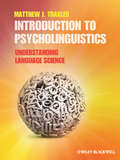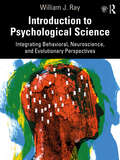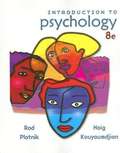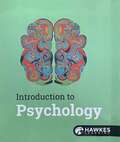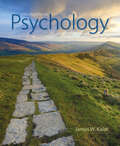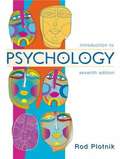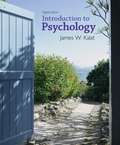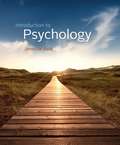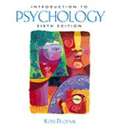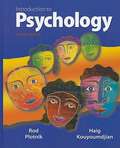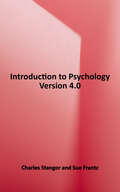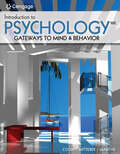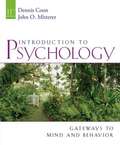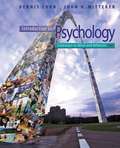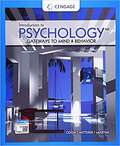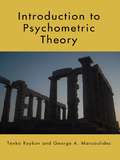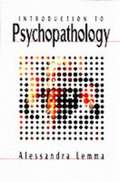- Table View
- List View
Introduction to Psycholinguistics
by Matthew J. TraxlerThis textbook offers a cutting edge introduction to psycholinguistics, exploring the cognitive processes underlying language acquisition and use. Provides a step-by-step tour through language acquisition, production, and comprehension, from the word level to sentences and dialogue Incorporates both theory and data, including in-depth descriptions of the experimental evidence behind theories Incorporates a comprehensive review of research in bilingual language processing, sign language, reading, and the neurological basis of language production and comprehension Approaches the subject from a range of perspectives, including psychology, linguistics, philosophy, computer science, neurology, and neurophysiology Includes a full program of resources for instructors and students, including review exercises, a test bank, and lecture slides, available online at www.wiley.com/go/traxler
Introduction to Psychological Science: Integrating Behavioral, Neuroscience and Evolutionary Perspectives
by William J. RayIntroduction to Psychological Science provides students with an accessible, comprehensive, and engaging overview of the field of scientific psychology. It expertly incorporates a variety of perspectives ranging from neuroscience to cultural perspectives at an introductory level. Ray brings together cutting-edge research from traditional psychological literature to modern, evolving perspectives, and creates a unified approach by focusing on three core themes: Behavior and Experience: an analysis of behavior and experiences observed across a variety of everyday life situations. Neuroscience: an examination of psychological experiences through neuroscience lens ranging from genetic/epigenetic to cortical networks as related to psychology. Evolutionary/Human Origins: an exploration of broader scientific questions by examining psychological processes from the perspective of human and cultural history. Through these themes, the book delves into topics like social processes, psychopathology, stress and health, motivation and emotion, developmental sequences, and cognitive functions such as memory, learning, problem solving, and language. Throughout it helps students to understand the nature of psychological science by addressing common myths and misconceptions in psychology, showing how psychological science can be applied to everyday life and how new research can be created. Additionally, this student-friendly book is packed with pedagogical features, including "concept checks" to test reader knowledge, "extensions" features which show how to apply knowledge, and a comprehensive glossary. Reflecting the latest APA Guidelines concerning the essential elements of an introductory psychology course, this text is core reading for all undergraduate introductory psychology students.
Introduction to Psychology
by Charles Stangor Jennifer Walinga"This textbook includes learning objectives, key takeaways, exercises and critical thinking activities, and a marginal glossary of key terms. In short, I [i.e. Charles Stangor] think that this book will provide a useful and productive synthesis between your goals and the goals of your students. I [i.e. Charles Stangor] have tried to focus on the forest rather than the trees and to bring psychology to life in ways that really matter for the students. At the same time, the book maintains content and conceptual rigor, with a strong focus on the fundamental principles of empiricism and the scientific method."--BC Campus website.
Introduction to Psychology
by Rod Plotnik Haig KouyoumdjianLike reading a magazine-not studying from a text-Plotnik's PSYCHOLOGY, EIGHTH EDITION will draw you in and show you how visual and exciting the study of psychology can be. Rod Plotnik's modular, visually-oriented approach to the fundamentals of psychology makes even the toughest concepts engaging and entertaining. Incorporating the latest research updates, the text breaks concepts down into small, easily digested chunks that give you and great flexibility how you approach and study the subject. This Eighth Edition expands upon Plotnik's commitment to helping you learn. For instance, For instance, "Learning Links" features in the text connect you to the newly updated PowerStudy 3. 0 CD-ROM. In addition, you can access the Book Companion Website that includes personalized Self-Study Assessments-giving you even further assistance in reviewing and prioritizing study time for maximum effectiveness.
Introduction to Psychology
by Hawkes Learning SystemsIntroduction to Psychology offers students a comprehensive guide to core psychological concepts. Aligned with APA learning outcomes, the course emphasizes disciplinary diversity and the skeptical habits of a scientific mind. It features engaging, interactive practice and contemporary, multi-modal learning that foster a meaningful exploration of a vast and growing field. <p><p>In a conversational tone, Introduction to Psychology leads students to a foundational and relevant understanding of psychology through a consistent focus on applying concepts in their own lives.
Introduction to Psychology
by James W. KalatJim Kalat's best-selling INTRODUCTION TO PSYCHOLOGY takes an "evaluate the evidence" approach that features a friendly writing style, hands-on "Try It Yourself" activities, and helpful visuals to invite students to engage in the experience of learning psychology. The modular organization breaks each chapter into meaningful "chunks" for structuring learning. Content is seamless, with nothing relegated to the margins or separated in boxes. "What's the Evidence" coverage reviews real studies, encouraging students to ask questions like, "Does the evidence really support the conclusion?" The Eleventh Edition draws on the latest research and literature to teach students how to separate the plausible from the scientifically demonstrable in the psychology classroom and beyond it. Instructor resources include an author-written test bank, ensuring high-quality, and accurate multiple-choice questions for assessment.
Introduction to Psychology
by Mcdougal LittellSome of the topics covered in this book include: the world of psychology, research in psychology, psychology & the brain, sensation, perception, consciousness, learning, memory and intelligence among others.
Introduction to Psychology Version 2.1
by Charles StangorIntroduction to Psychology Version 2.1 was collated to help students organize their thinking about psychology at a conceptual level.
Introduction to Psychology (7th Edition)
by Rod PlotnikDrawing students into psychology using a unique "magazine-style" format, Rod Plotnik's modular, visually-oriented approach to the fundamentals makes even the toughest concepts engaging and entertaining. Incorporating the latest research updates, the text breaks concepts down into small, easily digested chunks that allow students and instructors great flexibility in their approach to the subject. For students, this means the flexibility to learn at their own pace; for instructors, the flexibility to assign as much or as little as they like. This Seventh Edition expands upon Plotnik's commitment to teaching by extending the text's approach into its comprehensive ancillary package. For students, "Learning Links" features in the text connect them to the newly updated PowerStudy 2. 0 CD-ROM (see below for details). In addition, students have free access to a Book Companion Web Site that now includes personalized Self-Study Assessments-giving them even further assistance in reviewing and prioritizing study time for maximum effectiveness. For instructors, a detailed ancillary package centered around a comprehensive Instructor's Resource Manual provides everything needed for easier, more effective course preparation.
Introduction to Psychology (8th Edition)
by Rod Plotnik Haig KouyoumdjianLike reading a magazine-not studying from a text-Plotnik's Introduction to Psychology 8e will draw you in and show you how visual and exciting the study of psychology can be. Rod Plotnik's modular, visually-oriented approach to the fundamentals of psychology makes even the toughest concepts engaging and entertaining. Incorporating the latest research updates, the text breaks concepts down into small, easily digested chunks that give you and great flexibility how you approach and study the subject.
Introduction to Psychology (8th edition)
by James W. KalatFocusing on one type of behavior at a time, this textbook examines the roles biology, learning experiences, and social influences play in human intelligence, memory, perception, states of consciousness, cognition, motivation, and personality. The eighth edition updates references and adds sections on synesthesia, procrastination, and decision making. Annotation ©2007 Book News, Inc., Portland, OR (booknews.com)
Introduction to Psychology (Tenth Edition)
by James W. KalatJames Kalat's best-selling INTRODUCTION TO PSYCHOLOGY does far more than cover major theories and studies; it encourages you to question the information and ask yourself, "How was this conclusion reached?" and "Does the evidence really support it?" In this student-praised text, Kalat challenges your preconceptions about psychology to help you become a more informed consumer of information not only during your college experience but also as you venture into your post-college life. With his humorous writing style and hands-on "Try It Yourself" exercises, Kalat puts you at ease and gets you involved with what you are studying so that you can succeed in your course.
Introduction to Psychology 6th Edition
by Rod PlotnickThis introductory text is organized by self-contained modules rather than chapters, and features integration of colorful graphics and photos with text in smaller one- and two-page units. Material is accessibly written yet detailed, with illustrated explanations of difficult concepts related to physical and biochemical aspects, and many references to news events, public figures in entertainment and politics, and ongoing real-life cases. Other learning features include concepts reviews, summary tests, critical thinking exercises, and quizes. Plotnik teaches at San Diego State University. Annotation c. Book News, Inc. , Portland, OR (booknews. com)
Introduction to Psychology I (4th Edition)
by R. H. Ettinger<p>The 4th edition of Introduction to Psychology I is the most current introductory textbook available. It continues to present contrasting theoretical perspectives, while maintaining a strong scientific orientation to the study of psychology. For instance, while the text emphasizes a strong scientific perspective, it also presents competing points of view on several of the most important topics, including animal language, behavioral disorders and their treatment, and issues in social psychology. Some of the most noticeable changes to the 4th edition include the following: <p> <li>The addition of a section on sport psychology <li>Updated statistics on drug use <li>New research on how sleep functions to maintain brain homeostasis <li>New research on the neurobiology of emotions and the role of stress in disease <li>Revised discussion of attention deficit/hyperactivity disorder, its pathology, and its treatment <li>Revised discussion of the pathology and treatment of schizophrenia <li>New research on stereotype threat and sex differences <li>Updated discussion of facial symmetry and physical attractiveness</li> <p> <p>These enhancements help ensure a textbook that will provide the most current introduction to the science of psychology and behavior.</p>
Introduction to Psychology Ninth Edition
by Rod Plotnik Haig KouyoumdjianLike reading a magazine--not a textbook--Plotnik's INTRODUCTION TO PSYCHOLOGY, NINTH EDITION will draw you in and show you how exciting the study of psychology can be. Rod Plotnik's modular, visual approach to the fundamentals of psychology makes even the toughest concepts engaging and entertaining. As the pioneer of the "visual" or "magazine" style approach, each and every page of the text is individually planned, written, and formatted to effectively incorporate the use of Visual Cues, which help you to better remember information. Extensively updated, the text also utilizes "chunking," a method of breaking concepts down into small, easily digested sections that help you learn at your own pace.
Introduction to Psychology Version 4.0
by Charles Stangor Sue FrantzIntroduction to Psychology is a concise and conceptual introduction to the fascinating subject of psychology. This new version welcomes a co-author, Sue Frantz, who has worked with a diversity of students over the years. As a result, Sue contributes many fresh, classroom-based insights to enliven the text and bring it fully up to date. The core premises of this book remain constant, however. Featuring a central theme of action—predicting our actions and those around us—the narrative grabs students’ attention and does not let go. A strong underlying secondary theme of empiricism unifies the narrative under the umbrella of psychology as a science. Its standard, fourteen-chapter organization makes this textbook an ideal choice for either a typical semester- or quarter-long course.
Introduction to Psychology and Law
by Regina A. Schuller James R.P. OgloffDespite the notable Canadian presence in the field of psychology and law, there is currently no comprehensive Canadian textbook on the subject. While a few U.S. textbooks cover the field, they give little or no attention to Canadian law and research. In recognition of this problem, editors Regina Schuller and James Ogloff have put together an authoritative introduction to law and psychology for a Canadian audience. Within the fifteen chapters that comprise the book, leading Canadian scholars cover a wide range of topics spanning the applications of psychology - clinical, social, cognitive, developmental, experimental - in both criminal and civil areas of law. These include memory and eyewitness testimony, the jury, sentencing, competency to stand trial, criminal responsibility, and many others. The legal system in Canada serves as the backdrop for each of the chapters, which begin with an interesting case or anecdote that introduces the reader to some of the major issues facing psychologists and lawyers in this country.The book offers a compelling introduction to the field and a unique perspective to Canadian readers, especially students in psychology, criminology, and other disciplines in social science and law.
Introduction to Psychology: Gateways To Mind And Behavior (Mindtap Course List Series)
by Dennis Coon John Mitterer Tanya Martini<p>The text of choice at schools across the country, by an author who garners more accolades from instructors and students with each succeeding edition, INTRODUCTION TO PSYCHOLOGY: GATEWAYS TO MIND AND BEHAVIOR attracts-and holds-the attention of even difficult-to-reach students. Dennis Coon and new contributor John Mitterer have updated the proven-effective SQ4R learning system (Survey, Question, Read, Reflect, Review, Recite) by harnessing critical thinking to better help students understand psychology's broad concepts and great diversity of topics. Throughout every chapter, these active learning tools-together with the book's example-laced writing style, cutting-edge coverage of the field's new research findings, and superb new media resources-ensure that students will find the study of psychology fascinating, relevant, and above all, accessible.</p>
Introduction to Psychology: Gateways to Mind and Behavior
by Dennis Coon John O. MittererPsychology Textbook
Introduction to Psychology: Gateways to Mind and Behavior
by Dennis Coon John O. MittererNIMAC-sourced textbook
Introduction to Psychology: Gateways to Mind and Behavior (11th Edition)
by Dennis Coon John Otto MittererIn this new edition of his introductory text, Coon (author, editor, and former professor at Santa Barbara City College) presents 20 chapters that discuss the gamut of topics addressed by the discipline including the brain and behavior, life-span development, states of consciousness, conditioning and learning, memory, cognition, language and creativity, intelligence, motivation and emotion, gender and sexuality, stress and coping, psychological disorders, therapies, social behavior, culture, human relations, and behavioral statistics. Annotation (c)2003 Book News, Inc., Portland, OR (booknews.com)
Introduction to Psychology: Gateways to Mind and Behavior (Thirteenth Edition)
by Dennis Coon John O. MittererCo-written by an author who garners more accolades and rave reviews from instructors and students with each succeeding edition, INTRODUCTION TO PSYCHOLOGY: GATEWAYS TO MIND AND BEHAVIOR, THIRTEENTH EDITION attracts and holds the attention of even difficult-to-reach students. The Thirteenth Edition's hallmark continues to be its pioneering integration of the proven-effective SQ4R learning system (Survey, Question, Read, Reflect, Review, Recite), which promotes critical thinking as it guides students step-by-step to an understanding of psychology's broad concepts and diversity of topics. Throughout every chapter, these active learning tools, together with the book's example-laced writing style, discussions of positive psychology, cutting-edge coverage of the field's new research findings, and excellent media resources, ensure that users find the study of psychology fascinating, relevant, and above all, accessible.
Introduction to Psychology: Tenth Edition
by Rod Plotnik Haig KouyoumdjianRod Plotnik and Haig Kouyoumdjian's modular, visual approach to the fundamentals of psychology makes even the toughest concepts engaging and entertaining. As the pioneer of what's become known as the "visual" or "magazine style" text, Plotnik's INTRODUCTION TO PSYCHOLOGY remains the one developed on the strongest foundation of visual learning theory and research. Each and every page is individually planned, written, and formatted to effectively incorporate the use of Visual Cues, which help students to better remember information. The text also utilizes "chunking," a method of breaking concepts down into small, easily digested sections that help students learn at their own pace, and give instructors great flexibility in planning their courses. The Tenth Edition features a contemporary new design, over 500 new visuals, timely new topic coverage, and over 1,000 new references, all from recent years. The authors' commitment to visual learning is also reflected in the text's comprehensive ancillary package.
Introduction to Psychometric Theory
by George A. Marcoulides Tenko RaykovThis new text provides a state-of the-art introduction to educational and psychological testing and measurement theory that reflects many intellectual developments of the past two decades. The book introduces psychometric theory using a latent variable modeling (LVM) framework and emphasizes interval estimation throughout, so as to better prepare readers for studying more advanced topics later in their careers. Featuring numerous examples, it presents an applied approach to conducting testing and measurement in the behavioral, social, and educational sciences. Readers will find numerous tips on how to use test theory in today's actual testing situations. To reflect the growing use of statistical software in psychometrics, the authors introduce the use of Mplus after the first few chapters. IBM SPSS, SAS, and R are also featured in several chapters. Software codes and associated outputs are reviewed throughout to enhance comprehension. Essentially all of the data used in the book are available on the website. In addition instructors will find helpful PowerPoint lecture slides and questions and problems for each chapter. The authors rely on LVM when discussing fundamental concepts such as exploratory and confirmatory factor analysis, test theory, generalizability theory, reliability and validity, interval estimation, nonlinear factor analysis, generalized linear modeling, and item response theory. The varied applications make this book a valuable tool for those in the behavioral, social, educational, and biomedical disciplines, as well as in business, economics, and marketing. A brief introduction to R is also provided. Intended as a text for advanced undergraduate and/or graduate courses in psychometrics, testing and measurement, measurement theory, psychological testing, and/or educational and/or psychological measurement taught in departments of psychology, education, human development, epidemiology, business, and marketing, it will also appeal to researchers in these disciplines. Prerequisites include an introduction to statistics with exposure to regression analysis and ANOVA. Familiarity with SPSS, SAS, STATA, or R is also beneficial. As a whole, the book provides an invaluable introduction to measurement and test theory to those with limited or no familiarity with the mathematical and statistical procedures involved in measurement and testing.
Introduction to Psychopathology
by Alessandra LemmaAssessment and referral skills are essential for counselors and psychotherapists. However, these skills are dependent on the practitioner's understanding of the clinical manifestations of severe emotional distress: They must, for example, be able to recognize when clients are suffering from a psychotic episode. Introduction to Psychopathology provides a clear overview of the issues involved in our understanding of psychopathology and offers guidelines on appropriate interventions. Author Alessandra Lemma presents important topics, including how to arrive at psychiatric diagnoses and classifications, and explores issues that arise when working with clients in conjunction with other mental health practitioners. She addresses the needs of practitioners working with some of the more common forms of mental distress, including depression and anxiety, and clarifies those forms that might be less well-known, such as borderline personality disorder. A discussion of alternatives to mainstream approaches, including deconstructionist approaches, concludes the volume. Essential for students of counseling, psychotherapy, counseling psychology, and clinical psychology, Introduction to Psychopathology offers a framework for assessing clients that incorporates a broad range of models and approaches and takes into account psychological, social, and biological factors.
